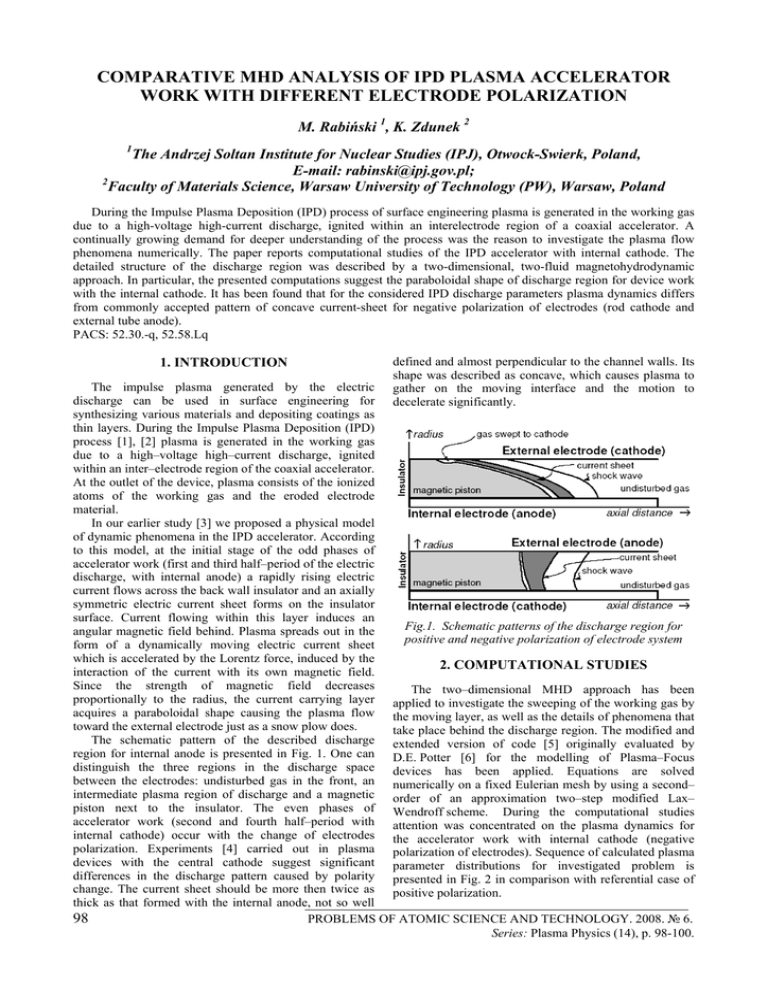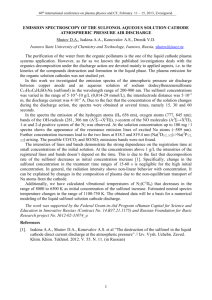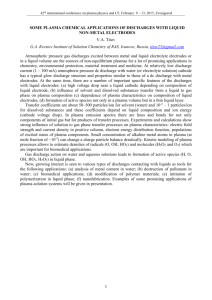COMPARATIVE MHD ANALYSIS OF IPD PLASMA ACCELERATOR
advertisement

COMPARATIVE MHD ANALYSIS OF IPD PLASMA ACCELERATOR WORK WITH DIFFERENT ELECTRODE POLARIZATION M. Rabiński 1, K. Zdunek 2 1 The Andrzej Soltan Institute for Nuclear Studies (IPJ), Otwock-Swierk, Poland, E-mail: rabinski@ipj.gov.pl; 2 Faculty of Materials Science, Warsaw University of Technology (PW), Warsaw, Poland During the Impulse Plasma Deposition (IPD) process of surface engineering plasma is generated in the working gas due to a high-voltage high-current discharge, ignited within an interelectrode region of a coaxial accelerator. A continually growing demand for deeper understanding of the process was the reason to investigate the plasma flow phenomena numerically. The paper reports computational studies of the IPD accelerator with internal cathode. The detailed structure of the discharge region was described by a two-dimensional, two-fluid magnetohydrodynamic approach. In particular, the presented computations suggest the paraboloidal shape of discharge region for device work with the internal cathode. It has been found that for the considered IPD discharge parameters plasma dynamics differs from commonly accepted pattern of concave current-sheet for negative polarization of electrodes (rod cathode and external tube anode). PACS: 52.30.-q, 52.58.Lq 1. INTRODUCTION defined and almost perpendicular to the channel walls. Its shape was described as concave, which causes plasma to gather on the moving interface and the motion to decelerate significantly. The impulse plasma generated by the electric discharge can be used in surface engineering for synthesizing various materials and depositing coatings as thin layers. During the Impulse Plasma Deposition (IPD) process [1], [2] plasma is generated in the working gas due to a high–voltage high–current discharge, ignited within an inter–electrode region of the coaxial accelerator. At the outlet of the device, plasma consists of the ionized atoms of the working gas and the eroded electrode material. In our earlier study [3] we proposed a physical model of dynamic phenomena in the IPD accelerator. According to this model, at the initial stage of the odd phases of accelerator work (first and third half–period of the electric discharge, with internal anode) a rapidly rising electric current flows across the back wall insulator and an axially symmetric electric current sheet forms on the insulator surface. Current flowing within this layer induces an Fig.1. Schematic patterns of the discharge region for angular magnetic field behind. Plasma spreads out in the positive and negative polarization of electrode system form of a dynamically moving electric current sheet which is accelerated by the Lorentz force, induced by the 2. COMPUTATIONAL STUDIES interaction of the current with its own magnetic field. Since the strength of magnetic field decreases The two–dimensional MHD approach has been proportionally to the radius, the current carrying layer applied to investigate the sweeping of the working gas by acquires a paraboloidal shape causing the plasma flow the moving layer, as well as the details of phenomena that toward the external electrode just as a snow plow does. take place behind the discharge region. The modified and The schematic pattern of the described discharge extended version of code [5] originally evaluated by region for internal anode is presented in Fig. 1. One can D.E. Potter [6] for the modelling of Plasma–Focus distinguish the three regions in the discharge space devices has been applied. Equations are solved between the electrodes: undisturbed gas in the front, an numerically on a fixed Eulerian mesh by using a second– intermediate plasma region of discharge and a magnetic order of an approximation two–step modified Lax– piston next to the insulator. The even phases of Wendroff scheme. During the computational studies accelerator work (second and fourth half–period with attention was concentrated on the plasma dynamics for internal cathode) occur with the change of electrodes the accelerator work with internal cathode (negative polarization. Experiments [4] carried out in plasma polarization of electrodes). Sequence of calculated plasma devices with the central cathode suggest significant parameter distributions for investigated problem is differences in the discharge pattern caused by polarity presented in Fig. 2 in comparison with referential case of change. The current sheet should be more then twice as positive polarization. thick as that formed with the internal anode, not so well 98 PROBLEMS OF ATOMIC SCIENCE AND TECHNOLOGY. 2008. № 6. Series: Plasma Physics (14), p. 98-100. Fig.2. Sequence of calculated plasma parameters distributions for the IPD accelerator (C = 100 μF, U = 6 kV, working gas – hydrogen at p= 20 Pa) for t = 12 μs. Electrodes’ length – 10 cm, the internal electrode radius – 0.7 cm and the outer electrode radius – 3.7 cm). Solution for internal cathode presented on the left, for internal anode – on the right, values of magnetic field normalized (for internal cathode multiplied by –1) 99 One can observe the differences in plasma dynamics caused by the polarization of electrodes. During the radial phase of accelerator work width of the current sheet for internal cathode is more then twice as thick as that formed with the internal anode, pinch column is shorter and the temperatures of electrons and ions are significantly lower. Nevertheless, the shape of discharge region is paraboloidal, as for the case of the rod anode and external cathode. For the positive polarization of electrodes in the region of acceleration outlet one can observe a separation of the plasma front. Two structures are separated because of the significantly higher velocities of forehead portion. This phenomenon is absent for discharge with internal cathode (compare the axial velocities in Fig. 2). 3. CONCLUSIONS Results of the presented above computational studies lead to the following conclusions. - The diffuse character of current sheet for accelerator work with internal cathode was verified. - For negative electrode polarization (rod cathode and external anode) pinch column is shorter, plasma density is higher and the temperatures of electrons and ions are significantly lower. - Results of the MHD modelling suggest the paraboloidal shape of discharge region for the IPD accelerator work with the internal cathode. It has been found that for the considered discharge parameters plasma dynamics differs from commonly accepted pattern of concave current–sheet for negative polarization of electrodes [4], the shape of discharge region is paraboloidal – as for the case of the rod anode and external cathode. Plasma parameters in the region of the electrodes' front head are very important for the quality of the coatings. Thus polarization of electrode system becomes one of the most important parameters of a compound– material synthesizing phase for the IPD process. REFERENCES 1. M. Sokołowski// J. Cryst. Growth. 1981, v. 54, p. 519-522. 2. M. Sokołowski, A. Sokołowska // J. Cryst. Growth. 1982, v. 57, p. 185-188. 3. M. Rabiński, K. Zdunek. Physical model of dynamic phenomena in impulse plasma accelerator // Vacuum. 1997, v. 20, p. 715-718. 4. J.C. Keck. Current distribution in a magnetic annular shock tube // Phys. Fluids. 1962, v. 5, p. 630–-632. 5. A.A. Skorupski, A. Senatorski. Numerical studies of the Mather type large Plasma Focus devices // Nukleonika. 1983, v. 28, p. 11–51. 6. D.E. Potter, Numerical studies of the Plasma Focus // Phys. Fluids. 1971, v. 14, p. 1911-1924. Article received 23.09.08. СРАВНИТЕЛЬНЫЙ МГД АНАЛИЗ РАБОТЫ ИПН ПЛАЗМЕННОГО УСКОРИТЕЛЯ С РАЗЛИЧНОЙ ПОЛЯРНОСТЬЮ ЭЛЕКТРОДОВ M. Рабинский, K. Здунек При импульсном плазменном напылении (ИПН) плазма генерируется из рабочего газа вследствие высоковольтного сильноточного разряда в межэлектродной области коаксиального ускорителя. Возрастающие потребности понимания происходящих процессов в плазменном потоке стимулировали проведение численного моделирования. Данная работа посвящена компьютерным исследованиям ИПН ускорителя с внутренним электродом–катодом. Детальная структура разрядной области описана в приближении двумерной двужидкостной магнитогидродинамики. В частности, представленные расчеты рекомендуют параболическую геометрию разрядной области при работе с внутренним электродом–катодом. Показано, что для рассматриваемых ИПН разрядов динамика плазмы отличается от общепринятой формы вогнутого токового слоя при отрицательной полярности электродов (стержневой катод и внешняя труба- анод). ПОРІВНЯЛЬНИЙ МГД АНАЛІЗ РОБОТИ ІПН ПЛАЗМОВОГО ПРИСКОРЮВАЧА З РІЗНОЮ ПОЛЯРНІСТЮ ЕЛЕКТРОДІВ M. Рабінський, K. Здунек При імпульсному плазмовому напилюванні (ІПН) плазма генерується з робочого газу унаслідок високовольтного потужнострумового розряду в міжелектродній області коаксіального прискорювача. Зростаючі потреби зрозуміння процесів, що відбуваються у плазмовому потоці, стимулювали проведення чисельного моделювання. Дана робота присвячена комп'ютерним дослідженням ІПН прискорювача з внутрішнім електродом-катодом. Детальна структура розрядної області описана в наближенні двовимірної двурідинної магнітогідродинаміки. Зокрема, представлені розрахунки рекомендують параболічну геометрію розрядної області при роботі з внутрішнім електродом-катодом. Показано, що для розглянутих ІПН розрядів динаміка плазми відрізняється від загальноприйнятої форми увігнутого токового шару при негативній полярності електродів (стрижневий катод і зовнішня труба - анод). 100


